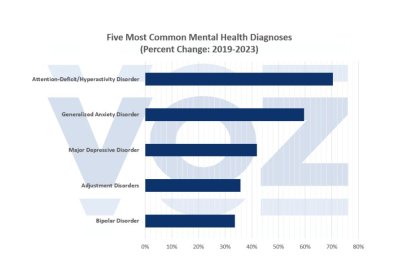Mental health diagnoses have skyrocketed in the past five years
From 2019 to 2023, cases grew by 39.8%. The condition with the largest increase was attention deficit hyperactivity disorder (ADHD).

(Unsplash)
The number of diagnoses for mental health problems skyrocketed by 39.8% in the past five years. As a result of this, a report from the FAIR Health organization states that the number of patients who received treatment increased from 13.5% in 2019 to 18.9% in 2023.
Among all mental health problems, the top five diagnoses in 2023 were generalized anxiety disorder (9.1%), major depressive disorder (5.7%), attention deficit hyperactivity disorder (ADHD) (3.1%), adjustment disorders (2.9%) and bipolar disorder (0.9%).
Of these five conditions, the one that grew the most from 2019 to 2023 was ADHD (70.4%), followed by generalized anxiety disorder (59.6%), major depressive disorder (41.9%), adjustment disorders (35.8%) and, finally, bipolar disorder (33.7%).

Diseño sin título - 2024-04-29T145655.478
Woman over 65 years old have highest growth in diagnoses
Across all age ranges, treatments for mental health problems increased over this five-year period. The one that experienced the greatest growth was those over 65 years of age, who had an increase of 57.4% from 2019 to 2023.
Behind them, people between 23 and 30 years old and those between 31 and 40 years old, with an increase of one 44.1% each; those between 41 and 50 years old, with an increase of 38.5%; and those between 19 and 22 years old, with an increase of 38.1%. The lowest growth was recorded in patients between 10 and 13 years old (18.6%).
By gender, women experienced a greater increase from 2019 to 2023 (44.6%) than men (32.7%). The increase from 2022 to 2023 was 21.9% for women and 15.4% for men.
Substance use, an additive to mental health problems
The analysis details that 15.7% of patients diagnosed with mental health problems also suffered from problems with drug use.
The diagnoses derived from substance use that grew the most from 2019 to 2023 were delusions and other schizoaffective disorders, which increased by 51.6%. Following this were schizophrenia (49.5%), personality disorders (42.5%), gambling addiction (40.4%), bipolar disorder (39.2%) and post-traumatic stress disorder (28.1%).
RECOMMENDATION





















